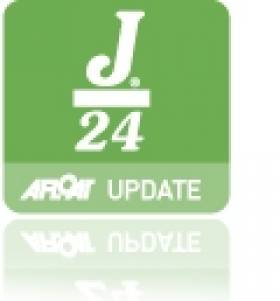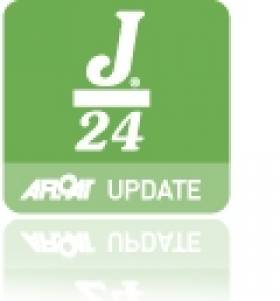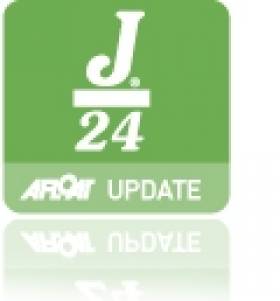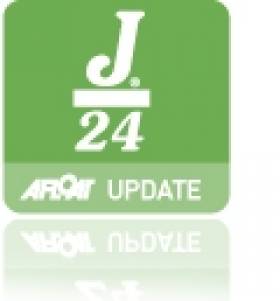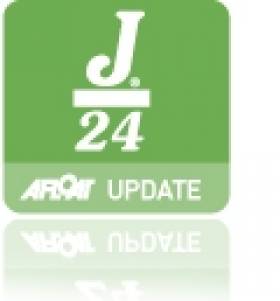Displaying items by tag: J24 onedesign keelboat
U.S.A's Healy wins BMW J24 Worlds at Howth
In a tense and closely fought final day, Tim Healy and his crew from Newport, Rhode Island, on board 'Helly Hansen' were impressive winners of the BMW J24 World Championship at Howth Yacht Club, with eight top-five results (including three race wins) in the 10-race series.
Healy, who previously won the title in 2010, was pushed all the way by the defending champion Mauricio Santa Cruz from Brazil on 'Bruschetta', who also demonstrated remarkable consistency, but who had to be content with the runner-up spot, four points adrift of his rival.
Third place overall went to another American crew led by Travis Odenbach from Rochester on 'Honey Badger' who had been the series leader overnight but who did not enjoy the final day. A 20th and an 8th effectively knocked his chances, although he was only two points off Santa Cruz in the end.
In fresh westerly winds which touched 25 knots at times, the penultimate race saw a second win in the series for Britain's Ian Southworth on 'Il Riccio', ahead of fellow Briton Bob Turner's 'Serco'. Third place went to local Howth skipper Mossy Shanahan on 'Crazyhorse', following up on his great form the previous day, a result which contributed to him finishing as the top Irish boat overall in 19th place.
Success in the last race went to the German boat 'Rotoman' (Tobias Feuerherd), with Keith Whittemore ('Furio') from Seattle 2nd and Santa Cruz 3rd. The Brazilian, however, needed Healy to be further down the fleet than his finishing place of 5th and so surrendered his world title to the American crew by four points after the one allowed discard.
With the exception of the Tuesday when racing was abandoned due to lack of wind, the championship featured four good racing days, with the wind strength progressively increasing as the week went on. There were six different race winners and the four US entries all finished in the top 10 which featured two German boats and the sole Italian entry.
After 10 races, the overall standings (after one discard) were:
1. Tim Healy (USA) 38 points
2. Mauricio Santa Cruz (Brazil) 42 points
3. Travis Odenbach (USA) 44 points
4. Ian Southworth (GB) 53 points
5. Tobias Feurherd (Ger) 73 points
6. Keith Whittemore (USA) 77 points
7. Bob Turner (GB) 83 points
8. Ignatio Bonanno (Italy) 88 points
9. Tony Parker (USA) 114 points
10. Sullberg (Ger) 115 points
http://www.hyc.ie/J24worldChampionship2013/
Americans Dominate Fourth Day at BMW J24 Worlds
It was very much a case of North American domination on the fourth day of competition at the BMW J24 Worlds at Howth Yacht Club, with Tim Healy of Newport winning the first and third races of the day while compatriot Travis Odenbach's win in the second one has taken the crew from Rochester, NY, into the overall lead going into the final day.
Conversely, it was not such a good day for the South Americans from Brazil as defending champion Mauricio Santa Cruz had his worst results of the series, highlighted by an 18th in the second race, which drops him to third overall. It proved a very good day, however, for Mossy Shanahan of the host club who scored a 6th, 3rd and 4th, each finish being the best local result in the series to date.
In fresh winds that fluctuated between south-west and west in direction, Healy enjoyed the conditions best to take the gun in the first race of the day from Britain's Ian Southworth and then Odenbach, while Santa Cruz's 7th dropped him from top spot after six races.
The biggest upsets came in the seventh race of the series, where several of the leading boats were caught out by a significant wind-shift on the first beat and eventually ended up in mid-fleet positions. Odenbach, on the other hand, clawed his way back superbly to take line honours ahead of Britain's Paul Williams and Ireland's Shanahan to open up a lead at the top of the leaderboard.
The series' eight race was another triumph for Healy and his crew but his biggest rival Odenbach secured a second for a highly consistent 3, 1, 2 scorecard for the day. After a poor result in the previous race, Ian Southworth returned to form to finish 3rd and move into 4th overall.
Two more races are scheduled for the final day (Friday 30th) to complete the 10-race programme, with all eyes on the two US crews and Santa Cruz as the main contenders for the title. Odenbach holds a 6-point lead over Healy who has only one point to spare over the Brazilian.
After 8 races, the provisional overall standings (with one discard) are:
1. Travis Odenbach (USA) 23 points
2. Tim Healy (USA) 29 points
3. Mauricio Santa Cruz (Brazil) 30 points
4. Ian Southworth (GB) 46 points
5. Rotoman (Ger) 55 points
6. I. Bonanno (Italy) 65 points
7. Keith Whittemore (USA) 68 points
8. Bob Turner (GB) 70 points
9. Sullberg (Ger) 88 points
10. Tony Parker (USA) 90 points
http://www.hyc.ie/J24worldChampionship2013/
Editor's note: When the J/24 Worlds came to his home port of Howth this week, W M Nixon found himself seeing familiar sailing waters as though for the first time. Read his sailing blog from midnight on Friday on Afloat.ie
Tight at the top at BMW J24 Worlds
In stark contrast to the previous day, ideal sailing conditions prevailed at Howth on the third day of the BMW J24 World Championship to allow three races to be completed, resulting in just seven points separating the top five boats after one discard is taken into account.
Defending champion Mauricio Santa Cruz from Brazil, a model of consistency with four top three finishes, leads the fleet overall but the crew from Rio is being pressed all the way by former World Champion Tim Healy of the USA who is only two points adrift. He in turn has only two points to spare over Britain's Ian Southworth.
The third race of the series, in fresh south-easterly winds, saw Healy take line honours ahead of Bob Turner (GB), another American Travis Odenbach and Santa Cruz.
Turner's boat, helmed by Nathan Batchelor, went one better in the fourth race with a comfortable margin of victory over Santa Cruz who had Ian Southworth (GB) chasing him. The British boat had a cracking start and the leading pack all gained by going right on the first beat.
Southworth, who was black-flagged with five other boats on the abandoned race on day 2 and carried the penalty into the third day, made up for that disappointment with a bullet in the fifth race. Healy finished up a satisfactory day with a second ahead of Santa Cruz to set up an interesting penultimate day of competition.
With five races completed, the provisional overall standings (with one discard) are:
1. Mauricio Santa Cruz (Brazil) 11 points
2. Tim Healy (USA) 13 points
3. Ian Southworth (GB) 15 points
4. Travis Odenbach (USA) 17 points
5. Keith Whittemore (USA) 18 points
6. I. Bonanno (Italy) 27 points
7. Bob Turner (GB) 32 points
8. Blankeneser SC (Ger) 32 points
9. Tony Parker (USA) 38 points
10. Joersfelder SC (Ger) 39 points
http://www.hyc.ie/J24worldChampionship2013/
Windless Conditions Stop Racing at Howth BMW J24 Worlds
#j24 – Lack of wind and strong tides played havoc on day two of the BMW J24 World Championship at Howth Yacht Club leaving Principal Race Officer David Lovegrove with no alternative but to abandon racing.
A 6-knot north-westerly breeze allowed the third race of the series to be started eventually but once the boats rounded the windward mark, the wind dropped away and a north-flowing flood tide meant the entire fleet was left motionless, with no chance of a finish.
After a delay of almost three hours, continued windless conditions forced abandonment for the day.
With the two races sailed on the first day the only ones to count so far, Keith Whittemore from Seattle still heads the overall rankings by two points from defending champion Mauricio Santa Cruz of Brazil.
Racing is expected to resume on Wednesday (28th).
American Crews Dominate Day One at BMW J24 Worlds
American crews led the way in both races on the first day of the BMW J24 World Championships at Howth Yacht Club today (Monday 26th).
After a two-hour delay for wind, the 40-boat fleet finally got away for the first race in a light but testing easterly breeze. First blood went to Tony Parker and his crew from Annapolis who experienced the Howth waters a week earlier at the Irish National Championship.
Fellow American Keith Whittemore from Seattle, who also sailed in the Irish event, followed him home in second place while defending World Champion Mauricio Santa Cruz from Brazil finished third, ahead of leading UK entry Ian Southworth.
American crews again led the way in the second race, with line honours going to former North American Champion Travis Odenbach from Rochester, with Whittemore second again and Santa Cruz taking another third spot. Newport's Tim Healy took fifth to make it three US boats in the top five.
After two races, Whittemore leads the overall rankings by two points from the Brazilians, with Britain's Ian Southworth (with a 4th and 7th) third. Leading Irish boat is 'Stouche' (Darrer/Murphy) from the host club, whose 10th and 8th place finishes have put them 7th overall.
McCaldin Wins Practice Race at BMW J24 Worlds
The BMW J24 World Championship, which has attracted 40 entries form 10 countries, gets underway in earnest at Howth Yacht Club on Monday 26th with the first two races in the week-long event.
A practice race on Sunday on the waters between Lambay Island and Ireland's Eye in light northerly/north-westerly winds saw half the fleet fail to complete the course, as is customary, while former Irish Champion JP McCaldin from Lough Erne took line honours ahead of Japanese entry Koji Matsumoto and G. Bonanno of Italy.
Among the favourites for the World title are defending champion Mauricio Santa Cruz (Brazil), Ian Southworth (GB), Tim Healy (USA) and Luis Olcese (Peru). Eleven Irish crews qualified for the event, with the young Howth U-25 crew on 'Euro Car Parks Killcullen', the new Irish champions, heading the local challenge.
J24 Worlds at Howth Attracts Quality Field
#j24– The defending World Champion from Brazil, the multiple European Championship winner, a former World Champion and a past North American Champion are among the quality field lined up to contest next week's BMW J24 World Championship at Howth Yacht Club which has attracted 42 entries from 10 countries.
Mauricio Santa Cruz from Rio de Janeiro, who has won the title four times since 2006, most recently last year, is clearly the man to beat but he won't be short of competition. Ian Southworth of Britain, who dominated the Irish Nationals last week, won the Europeans on Howth waters two years ago and has tasted success at that level five times in total.
The world's most popular one-design keelboat, the J24 is particularly strong in the USA from where several strong contenders have arrived. Among the leading lights is the 2010 World Champion Tim Healy from Newport and Travis Odenbach from Rochester, a former North American Champion.
Luis Olcese from Peru has consistently been at the top end of J24 fleets at various international venues and so has Japan's Koji Matsumoto, so much is expected of them while there are a few useful German entries and leading GB entries such as Bob Turner.
Local hopes centre on the young Howth U25 Keelboat Team which last weekend took the Irish title by sailing consistently throughout the 8-race series on home waters to finish behind five visitors as the leading Irish boat. Other Irish in contention will include Flor O'Driscoll, J-P McCaldin and the Darrer/Murphy partnership.
The Worlds will be officially opened by the Mayor of Fingal Cllr. Kieran Dennison on Saturday 24th (6pm), there's a practice race on Sunday, and the real action starts on Monday (26th) with two races a day until Friday (30th). PRO is International Race Officer David Lovegrove.


























